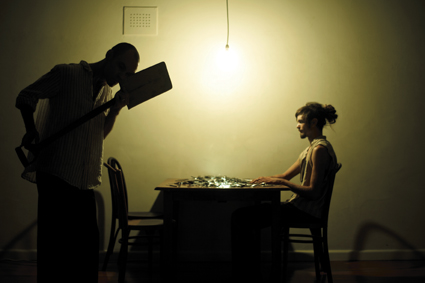the uneasy weight of metaphor
virginia baxter: shaun mcleod, the weight of the thing left its mark

Paul Romano, Luke Hickmott, The weight of the thing left its mark, Shaun McLeod
photo Heidi Romano
Paul Romano, Luke Hickmott, The weight of the thing left its mark, Shaun McLeod
DIM LIGHT GRADUALLY REVEALS THREE PEOPLE MID-STAGE SEATED AT A SIMPLE WOODEN TABLE, A LARGE PILE OF CUTLERY GLEAMING ALONG ITS LENGTH. ONE OF THE THREE SLUMPS FORWARD ONTO THE TABLE. ANOTHER HOVERS CLOSE BY. A NAKED LIGHT BULB SWINGS. AT THE OTHER END OF THE SPACE A WHEAT SACK IS SUSPENDED FROM A ROPE. THIS PORTENTOUS SCENARIO LURES US WILLINGLY IN TO THE WEIGHT OF THE THING LEFT ITS MARK, A WORK CONCEIVED BY SHAUN MCLEOD TO “WALK THE LINE BETWEEN CHOREOGRAPHY AND ‘PURE’ IMPROVISATION,” REVEALING “(THE) PSYCHOLOGICAL IMPACT INHERENT IN NEGOTIATIONS THAT TAKE PLACE BETWEEN PEOPLE” (PROGRAM NOTE).
A cacophony of metallic sounds ensues as the cutlery is variously manipulated both onstage and enhanced by sound artists, Madeleine Flynn and Tim Humphrey seated in the shadow of the dangling sack at the other end of the space.
As the wielding of knives and forks moves from tentative to provocative, one woman (Olivia Millard) is driven to leave the suffocating tension of the table. Adrift from the rest, in a discombobulated dance that leads nowhere, she appears purposeful but ineffectual as if performing half-remembered moves, inhabiting a broken body not her own.
Sometimes I think dance is all about the variously faltering and fluid manifestations of evolution’s trace memory. But enough of the weighty projection…
Light shifts and, with it, attention. I lose myself for a time in the ethereal ambience of the sound. Like the onstage performers, Madeleine Flynn explores the myriad possibilities of cutlery. Her close-miked clinks, clanks, scrapes and drops are processed by Tim Humphrey into resonant frequencies, textural and tonal swathes of sound, subtle feedback and fleeting musical phrases.

Sophia Cowen, Luke Hickmott, Olivia Millard, Paul Romano, The weight of the thing left its mark
photo Heidi Romano
Sophia Cowen, Luke Hickmott, Olivia Millard, Paul Romano, The weight of the thing left its mark
Back in the room, the performers (family members, conflicted committee, coven?) eventually assemble in a line across the stage wielding knives, forks and spoons in a series of manoeuvres, some more suggestive than others—such are the risks of improvisation. The tight focus of the opening begins to fall away in unfocussed display. Cutlery is deployed in a variety of unlikely conjunctions then flung to the floor. But for all their materiality, their multiplication in volume and enhancement in sound, the symbolic power of these objects begins to diminish. At one oddly anticlimactic point Flynn slashes the wheat bag open, releasing the grain. Its moment is lost.
As meaning floats, signifiers drift by. The men threaten, then submit to, even carry one another while the women play small games of attraction/repulsion. The bodies are uniformly loose, unevenly weighted and without apparent purpose. Curiously, at times performers opt out of the action, then return (if only this were possible in real life). Gradually the mind conjures from these flailing figures something other than human nature—some other species negotiating space and decision-making, occasionally submitting to domination by one of the pack (another improvisational pitfall). Then again I might have been watching too much David Attenborough.
None of the movement really hits its mark it seems until a couple of larger tools—a spade and a pitchfork—appear in the hands of the performers. This upping of the ante offers an opportunity for some stronger reactions from the ensemble, though again, males dominate somewhat. For the first time we hear spoken observations or instructions from one of the women (Sophia Cowen) on the relationship between the object and the body holding it: “It’s heavier in the left hand,” she says and refers us to the “torso” of the fork. Finally, the young man (Luke Hickmott) who had stood apart from those gathered at the table at the outset breaks loose again. He holds the spade like a musical instrument, then aloft, then suddenly feels its weight and falls. It leads him into a perilous spin and back to the table. In this physical movement I begin to feel something of the metaphorical weight at the centre of this work.
The weight… is most certainly a thoughtful work with many ambient pleasures but, later the same night, watching the pervasive invention and sheer choreographic distinctiveness of Rosalind Crisp’s equally improvisatory No one will tell us…, I understood what was missing.
–
Dance Massive: The weight of the thing left its mark, director, choreographer Shaun McLeod, performer-choreographers Olivia Millard, Paul Romano, Sophia Cowen, Luke Hickmott, sound Madeleine Flynn, Tim Humphrey, lighting Gwen Holmberg-Gilchrist, Upstairs Studio, Dancehouse, Melbourne, March 16, www.dancemassive.com.au
See also an interview with musician/composers Madeleine Flynn & Tim Humphrey about their installation Music for Imagined Dances also part of Dance Massive 2011.






